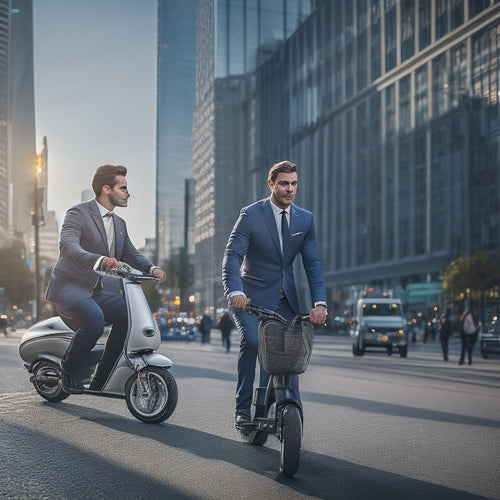
Urban Planning for a Sustainable EV Future
Share
In addition to planning for a sustainable EV future, you're prioritizing strategic EV charging infrastructure development, deploying 20,000 public charging points annually, and optimizing station design for convenient, accessible, and safe public access points. You're also integrating 7 million EVs into urban transportation systems by 2030, utilizing sustainable urban mobility strategies like Mobility Hubs and Bike Sharing. Furthermore, you're revising zoning laws to accommodate EV charging infrastructure and preserving green spaces to mitigate the urban heat island effect. Now, discover how to leverage smart city transportation systems and data analytics to create a resilient, livable city for future generations.
Key Takeaways
• Strategically deploy 20,000 public EV charging points per year, focusing on accessibility, safety, and user experience.
• Integrate 7 million EVs into urban transportation systems by 2030, prioritizing efficient traffic flow and sustainable mobility options.
• Revise zoning laws to require EV charging infrastructure in new constructions, allocating parking spaces for EV charging and designating routes for infrastructure.
• Preserve green spaces to mitigate the urban heat island effect, conducting ecological restoration and urban forestry to improve air quality.
• Implement smart city transportation systems, leveraging real-time traffic management and data analytics for optimized traffic flow and reduced emissions.
EV Charging Infrastructure Development
As urban planners, you'll need to prioritize the strategic deployment of approximately 20,000 public EV charging points per year over the next decade to support the anticipated 7 million EVs on American roads by 2030. To achieve this, you'll need to focus on optimizing charging station design and public access points.
Important charging station design is vital, considering factors like accessibility, safety, and user experience. You'll need to make sure that charging stations are conveniently located, well-lit, and easily accessible, with clear signage and minimal obstacles.
Public access points are equally important, as they'll be the primary interface between EV owners and the charging infrastructure. You'll need to take into account the type and speed of charging, as well as the payment and authentication processes.
By strategically placing public access points in high-demand areas, such as shopping centers, parking garages, and highway rest stops, you can provide EV owners with convenient and reliable charging options.
Sustainable Urban Mobility Strategies
By 2030, you'll need to integrate approximately 7 million EVs into urban transportation systems, necessitating the development of sustainable urban mobility strategies that prioritize efficient traffic flow, reduced congestion, and minimized environmental impact.
As you plan for this future, you'll need to rethink urban mobility to accommodate the influx of EVs. One key strategy is the creation of Mobility Hubs, which will serve as centralized transportation nodes, offering a range of mobility options, including EV charging, public transit, and bike-sharing services.
Bike Sharing, in particular, can play an essential role in reducing congestion and emissions by providing an alternative to private car ownership. By integrating these services, you can create a seamless travel experience that encourages the use of sustainable transportation modes.
Additionally, Mobility Hubs can be designed to prioritize pedestrian-friendly and cyclist-friendly infrastructure, further reducing reliance on personal vehicles. By adopting these sustainable urban mobility strategies, you can ensure a smoother, more environmentally friendly shift to an EV-dominated transportation system.
Electric Vehicle-Friendly Zoning Laws
You'll need to revise outdated zoning laws to accommodate the rising demand for EV charging infrastructure, ensuring that new buildings and developments incorporate EV-friendly design elements and amenities. This shift in land use planning will require municipalities to rethink their approach to building codes and zoning regulations.
To create EV-friendly zoning laws, consider the following key components:
-
EV-ready buildings: Update building codes to require new constructions to include EV charging infrastructure, such as electrical outlets and conduits.
-
Designated EV parking: Allocate a percentage of parking spaces for EV charging, ensuring convenient and accessible charging options.
-
Charging corridors: Designate specific routes or areas for EV charging infrastructure, streamlining the charging process and reducing congestion.
Green Space Preservation Methods
In conjunction with updating zoning laws to accommodate EV infrastructure, municipalities must also prioritize green space preservation methods to mitigate the urban heat island effect and maintain ecological balance. As you plan for a sustainable EV future, you'll need to take into account the importance of preserving natural habitats within urban areas.
This can be achieved through ecological restoration efforts, which involve rehabilitating degraded or damaged ecosystems. By doing so, you'll not only improve air quality and mitigate the urban heat island effect but also provide habitats for urban wildlife.
Urban forestry is another vital aspect of green space preservation. By planting and maintaining trees within urban areas, you'll reduce air pollution, absorb carbon dioxide, and provide shade for pedestrians and buildings. This, in turn, will decrease the need for air conditioning and lower energy consumption.
Additionally, urban forests can serve as natural buffers against extreme weather events, protecting cities from flooding and strong winds. By incorporating green space preservation methods into your urban planning strategy, you'll create a more sustainable, resilient, and livable city for generations to come.
Smart City Transportation Systems
As cities shift to electric vehicles, integrating smart city transportation systems becomes essential to optimize traffic flow, reduce congestion, and decrease emissions. You, as a city planner, play an important role in designing a sustainable transportation infrastructure. By leveraging technology and data analytics, you can create a seamless travel experience for citizens while minimizing environmental impact.
Here are three key strategies to contemplate:
-
Real-time Traffic Management: Implement intelligent traffic signals that adjust to traffic conditions in real-time, reducing congestion and minimizing travel times.
-
Pedestrian Safety: Design pedestrian-friendly infrastructure, such as dedicated pedestrian zones and smart crosswalks, to guarantee safe and accessible mobility for all citizens.
-
Data-Driven Insights: Leverage data analytics to monitor traffic patterns, identify bottlenecks, and optimize traffic flow, enabling data-driven decision-making for urban planning.
Frequently Asked Questions
How Will Urban Planning Address Unequal Access to EV Charging Stations?
As you navigate the complexities of EV adoption, you'll encounter "charging deserts" where access is limited, exacerbating existing inequalities. To address this, you'll need to employ equity mapping to identify and prioritize underserved communities, ensuring a more inclusive charging infrastructure.
Can Self-Driving EVS Reduce Traffic Congestion in Urban Areas?
Picture yourself driving on a busy highway in a self-driving EV, smoothly merging with other autonomous vehicles using Smart Merging, which, combined with Dynamic Routing, optimizes traffic flow, reducing congestion by up to 30% in simulations like the one conducted in Helsinki.
Will EV Adoption Lead to Increased Urban Sprawl and Development?
You'll likely see EV adoption influencing land use patterns, potentially leading to increased urban sprawl as people opt for more rural or suburban areas, altering urban form and development densities.
How Can Urban Planners Balance EV Infrastructure With Pedestrian-Friendly Spaces?
As you design cities, you'll need to balance EV infrastructure with pedestrian-friendly spaces by incorporating green corridors and promoting urban densification, ensuring efficient land use while preserving walkability and community engagement.
Can EVS Be Designed to Serve as Energy Storage for Urban Power Grids?
You're wondering if EVs can serve as energy storage for urban power grids. Yes, they can! Vehicle-to-Home (V2H) technology enables EVs to supply energy back to the grid, enhancing grid resiliency during peak demand or outages.
Related Posts
-

Why Choose Affordable Electric Scooters for Urban Commuting
By choosing an affordable electric scooter for urban commuting, you'll not only reduce your transportation costs by u...
-

Why Regular Vehicle Panel Maintenance Matters Locally
You know that regular vehicle panel maintenance is essential to optimize your vehicle's performance, energy efficienc...
-

Designing Efficient Vehicle Charging Infrastructure Systems
As you design efficient vehicle charging infrastructure systems, prioritize strategic planning and optimization to av...


